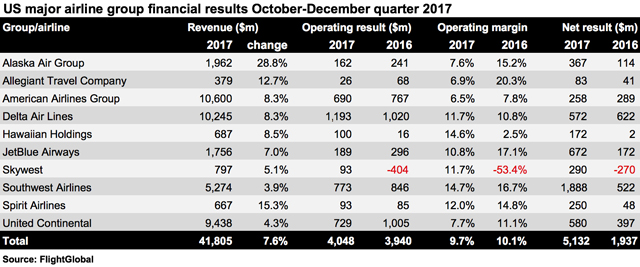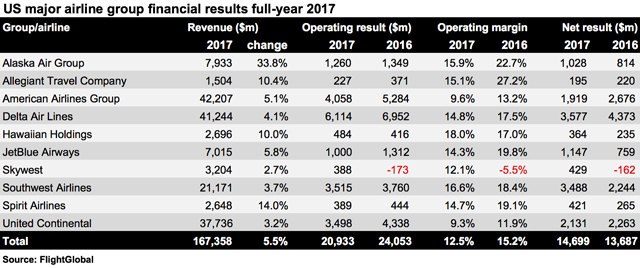The US airline industry's profitable streak continued in the fourth quarter of 2017, with the nation's carriers – low-fare and network alike – earning billions in profits even as costs crept higher.
While returns remained strong, most carriers reported year-on-year declines in operating profits, citing higher fuel and labour costs and increasing competition.
Collectively, the 10 large publicly traded US airlines earned operating profits of just over $4 billion in the fourth quarter, up slightly on last year.

The industry's net profits more than doubled to $5.13 billion, but the gains largely reflect revaluations by carriers of deferred tax liabilities and assets following the December 2017 overhaul of the US tax code.
Still, airlines reported strong demand for travel in a healthy economy, and all reported revenue gains. The carriers' executives also predict continued capacity expansion in 2018, with United Airlines standing out for its relatively aggressive 2018 growth plan.
United's fourth-quarter operating profit slid 27.5% to $729 million, while its passenger revenue per available seat mile (PRASM) inched up just 0.2% year-on-year – a rate significantly lower than that reported by American Airlines and Delta Air Lines.
United, which in recent quarters has reported downward pressure on fares due to low-cost competition, saw fourth-quarter revenue increase just 4.3% year-on-year, while expenses jumped 8.2%, it reported.
The carrier's executives raised analysts' eyebrows during the 2017 earnings call when they announced plans to expand capacity by 4-6% annually up to 2020 by adding more flights from hubs to small US cities.
United described the move as a means to funnel higher yielding traffic through its hubs, but investors reacted negatively, sending United's share price tumbling 15% in two days.
Although other airline stocks also dipped on the news, some investment analysts called the sell-off overblown and expressed optimism in United's plan.
CORPORATE STRENGTH
American's fourth-quarter operating profit slipped 10% year-on-year to $690 million, while its PRASM jumped 5.4%, marking the carrier's fifth consecutive quarter of increasing unit revenue. Executives cited strong corporate sales.
The carrier's cost per available seat mile (CASM) increased 7.1% year-on-year in the quarter, reflecting higher fuel costs and increases in pilot and flight attendant salaries, American said.
American also plans to add capacity through its hubs in 2018, but will expand available seats by a modest 2.5%, it has said.
Delta bested its network carrier peers in the fourth quarter, reporting a 17% year-on-year jump in operating profit to $1.2 billion. The airline's revenue jumped 8%, driven by demand from corporate clients and strong ancillary and cargo revenue, it said.
Delta was also the only network carrier to report a year-on-year decline in fourth quarter CASM excluding fuel expenses, with the figure down 0.4%.
Low-fare giant Southwest Airlines' operating profit slipped 8.6% in the fourth quarter, although the carrier still earned $773 million. Southwest's unit costs increased by about 4% as a result of higher salary and benefit expenses and costs associated with achieving certification for extended over-water operations, it said.
Southwest needs that certification to begin flights to Hawaii, which it hopes to do this year.
Southwest's fourth-quarter unit revenue inched up only 0.5% year-on-year.
Alaska Air Group, owner of Virgin America and Horizon Air, reported a 33% drop in operating profit to $162 million in the fourth quarter. The company's PRASM fell 5.1% in the quarter, which executives have attributed to competitive pressure on routes from California operated by Virgin. The Seattle company, long known for its cost-cutting acumen, saw unit costs inch up 0.6% in the quarter. The company expects unit costs to continue climbing in 2018, then be flat or down slightly in 2019 and 2020.
Alaska expects to fully integrate Virgin with Alaska Airlines on 25 April, the date the company intends to transition both airlines into the same passenger service system, the technology that manages sales, flight scheduling, check-in and other functions.
RETIREMENT BENEFITS
Hawaiian Holdings stood out among all US carriers, reporting that its operating profit increased more than six times to $100 million in the fourth quarter. The Honolulu-based airline's CASM declined 9.5% year-over-year in the period, largely reflecting higher 2016 expenses related to retiring Boeing 767s.
Hawaiian expects that a surge in capacity between the Hawaiian islands and the US mainland will push down unit revenue in 2018, although it sees competitive advantages from its expanding fleet of A321neos.
JetBlue Airways' operating profit tumbled 36% in the fourth quarter to $189 million, partly reflecting the financial impact of hurricanes last year and a one-time bonus of $1,000 each paid to employees. JetBlue's fourth-quarter CASM jumped 10.8%, while PRASM inched up 0.8%.
The New York-based carrier expects to increase capacity by 6.5-8.5% in 2018, and will soon wrap up a fleet review that could shed light on its Embraer 190 plans and a possible order for Airbus A321LRs, a type that would give JetBlue transatlantic range.
Ultra-discounter Spirit Airlines' operating profit jumped 8.5% year-on-year in the fourth quarter to $93 million. The carrier has benefited from a decision to reduce some flying on Tuesdays and Wednesdays, when demand is light. Spirit continues to add new routes and expects capacity to jump 23% this year.
Low-cost competitor Allegiant Air's operating profit sagged 62% year-on-year in the fourth quarter to $26 million. The company's CASM surged 18%, although the gain partly reflects a $35 million charge resulting from the accelerated retirement of Boeing MD-80s.
Allegiant expects all those aircraft will be out of the fleet by the end of 2018.

Source: Cirium Dashboard


























